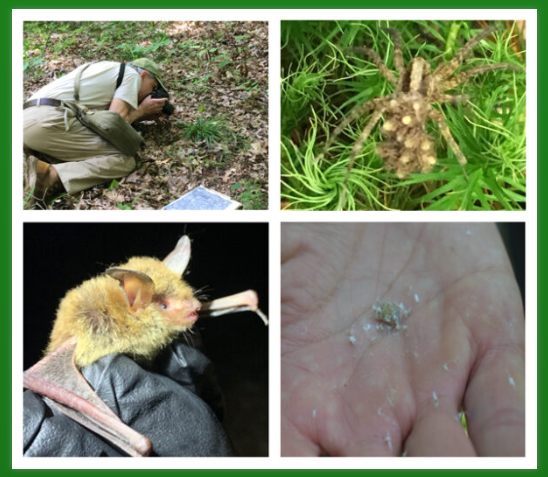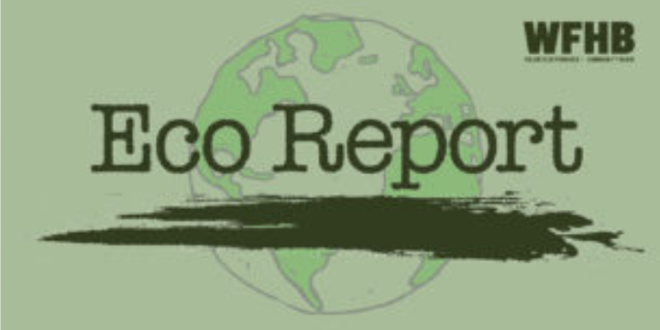Podcast: Play in new window | Download (Duration: 29:43 — 40.9MB)
Subscribe: RSS
| Hello and welcome to Eco Report. For WFHB, I’m Julianna Dailey. And I’m Frank Marshalek. Coming up later in today’s episode, we learn about the EcoBlitz wildlife survey program monitoring biodiversity and bat populations in Indiana which discovered a new species of bee. We also get details about an upcoming forest protection roundtable as Environmental Correspondent Zyro Roze speaks with Steven Stewart, the Hoosier National Forest Program Director for the Indiana Forest Alliance. |
|
And now for your environmental reports: A letter to the Indianapolis Business Journal outlines something that would improve Indiana. The letter was written by Larry Clemens, Indiana state director of The Nature Conservancy.His letter is in response to the recent article, “Indiana lawmakers could further dilute state wetlands protections following SCOTUS decision” [by Casey Smith, Indiana Capital Chronicle, IBJ.com, July 26]. The article did a great job of citing the benefits of wetlands, particularly their ability to catch and hold excess stormwater. As storms intensify throughout Indiana with each passing year, this is a benefit we cannot live without. What the article failed to mention is how Hoosiers reacted strongly two years ago when the General Assembly threatened to remove all state regulation from wetlands. Polling shows a majority of Hoosiers favor sensible regulatory protection of this critical resource, yet wetlands remain a target of developers with powerful connections. It’ll take a strong and sustained effort from Hoosiers across the state to ensure we don’t lose these important natural assets. —Norm Holy |
| The New York Times reported a story about the fires on Maui that has a good outcome.
Jennifer Pribble was asleep when the power line fell in the forest. She heard the generator kick in but didn’t think much of it. High winds sometimes led to electricity failures. It was normal enough. Wildfires were not even on her radar. Ms. Pribble lives at the Maui Bird Conservation Center, where she helps care for some of the most critically endangered birds in the world. Hawaii’s native birds have been decimated by disease fueled by climate change and by introduced predators like rats. The center keeps some 80 birds in enclosures in an effort to prevent their extinction. On Monday night, Ms. Pribble was the only staff member at the center, one of two in Hawaii managed by the San Diego Zoo Wildlife Alliance. As she slept, a downed line appears to have started a fire in the pine forest nearby. Several hours later, at about 3 a.m., Ms. Pribble awoke again, this time to the thud of a large branch hitting the roof. Still unaware of the fire, she worried it might have damaged the building and went onto the back porch to check. The sky was orange and there was smoke in the air, like out in the forest, Ms. Pribble said. She went outside to see what was happening, and saw flames about 150 feet from the edge of the property. She called 911, and was told the Fire Department knew about the blaze and was assessing. The center houses about 40 ‘akikiki, a native songbird, and about 40 ‘alalā, also known as the Hawaiian crow. ‘Alalā are extinct in the wild, and only about five ‘akikiki are known to remain there. The only other members of these species live at the center’s sister facility on the Big Island, said Emily Senninger, a spokeswoman for the San Diego Zoo Wildlife Alliance. The birds are divided between both places to insure against disasters such as this one. But until now, they thought volcanic eruptions and hurricanes were the biggest dangers. As Ms. Pribble watched the fire in the distance, she felt reassured that it was in the forest, where a bed of thick pine needles seemed to be making it hard for the flames to spread. For a time, they actually reduced in size. But she grew increasingly worried as fire approached grasses closer to a road. If it crossed, she thought, the grasses on the 46 acre property would provide ample fuel. “It’s pretty dry,” she said. Rising temperatures appear to be contributing to reduced rain in Hawaii, climatologists say, and more than a third of Maui County is in moderate or severe drought. A neighbor came over to see what was going on, and while he was there, the fire started climbing the hillside toward them. All of a sudden, basically, the fire jumped the road and it was on our property, she said. Ms. Pribble ran inside to get two fire extinguishers to douse the flames, but she worried it would happen again. She raced back in for more extinguishers and a garden hose. She texted the forest manager saying she needed assistance. We just went out and kept it under control the best that we could, just so it didn’t cross back over the road, until the state firefighters could arrive. She didn’t think about how the birds she was protecting were among the last of their kind, she said. She just acted, doing all she could to keep the facility safe. State firefighters arrived about 40 minutes later — as fast as possible, she said, given the distance involved. The forest is still smoldering, and occasionally flames will rekindle. But firefighters have it contained, she said. Luckily the smoke mostly blew away from the birds, which were moved to the safest enclosures and appear to have escaped any harm. I’m just in shock that all this happened, Ms. Pribble said. Now that we see the scale of things on the island of Maui, we’re very lucky that it wasn’t any worse. —Norm Holy |
| According to The New York Times the Clean Energy Future Is arriving faster than you think. The United States is pivoting away from fossil fuels and toward wind, solar and other renewable energy, even in areas dominated by the oil and gas industries. Across the country, a profound shift is taking place that is nearly invisible to most Americans. The nation that burned coal, oil and gas for more than a century to become the richest economy on the planet, as well as historically the most polluting, is rapidly shifting away from fossil fuels.
A similar energy transition is already well underway in Europe and elsewhere. But the United States is catching up, and globally, change is happening at a pace that is surprising even to the experts who track it closely. Wind and solar power are breaking records, and renewables are now expected to overtake coal by 2025 as the world’s largest source of electricity. Automakers have made electric vehicles central to their business strategies and are openly talking about an expiration date on the internal combustion engine. Heating, cooling, cooking and some manufacturing are going electric. As the planet registers the highest temperatures on record, rising in some places to levels incompatible with human life, governments around the world are pouring trillions of dollars into clean energy to cut the carbon pollution that is broiling the planet. We look at energy data on a daily basis, and it’s astonishing what’s happening, said Faith Birol, the executive director of the International Energy Agency. Clean energy is moving faster than many people think, and it’s become turbocharged lately. More than $1.7 trillion worldwide is expected to be invested in technologies such as wind, solar power, electric vehicles and batteries globally this year, according to the I.E.A., compared with just over $1 trillion in fossil fuels. That is by far the most ever spent on clean energy in a year. We in Indiana are unaware of this rapid development; it’s as if the state has fallen decades behind. The legislature forbids the mention of “climate change”, and refused to deal with a petition signed by 20,000 high school students, calling for climate change legislation. That many Republican politicians receive campaign funding from industries in the coal business explains their actions. —Norm Holy |
| A New York Times article says during a summer of scorching heat that has broken records and forced Americans to confront the reality of climate change, conservatives are laying the groundwork for a future Republican administration that would dismantle efforts to slow global warming.
The move is part of a sweeping strategy dubbed Project 2025 that Paul Dans of the Heritage Foundation, the conservative think tank organizing the effort, has called a “battle plan” for the first 180 days of a future Republican presidency. The climate and energy provisions would be among the most severe swings away from current federal policies. The plan calls for shredding regulations to curb greenhouse gas pollution from cars, oil and gas wells and power plants, dismantling almost every clean energy program in the federal government and boosting the production of fossil fuels — the burning of which is the chief cause of planetary warming. The plan basically says society will not spend anything to address climate change, but will leave it for future generations to spend trillions. —Norm Holy |

And now, we turn to Zyro Roze as he speaks with Steven Stewart of the Indiana Forest Alliance about threats to wildlife in our state, some hopeful signs of recovery and the lineup of the Ancient Forests Initiative Roundtable this weekend in Bloomington which is to include an activist working to stop Cop City, a police training facility and film studio poised to destroy an urban forest in Atlanta, Georgia.
|
| For Eco Report, I am Julianna Dailey. And, I am Frank Marshalek. Are you looking for a way to make a difference on environmental issues? Here at Eco Report we are currently looking for reporters, engineers, and segment producers. Our goal is to report facts on how we’re all affected by global climate disruption and the ongoing assaults on our air, land and water. We also celebrate ecologists, tree huggers, soil builders and an assortment of champions who actively protect and restore our natural world, particularly those who are active in south central Indiana. All levels of experience and all ages are welcome, and we provide the training you’ll need. WFHB also offers internships. To volunteer for Eco Report, give us a call at (812) 323-1200, or e-mail us at: [email protected]. |
|
And now for some upcoming events: Sycamore Land Trust is hosting a Wildflower Walk on Saturday, August 19th, from 8 to 10:30 am at the Touch the Earth Natural Area near Columbus, Indiana. Enjoy the prairie habitat on the 10-acre native wildflower meadow with Education Director Mary Welz. Sign up at [email protected]. |
| Brown County State Park is hosting an event titled Timber! Understanding the Timber Rattlesnake on Saturday, August 19th, from 3 to 4 pm in the Nature Center. Get an up close and personal look at Indiana’s most venomous and most misunderstood snake. Learn its history and all about venom. |
| An Explore Monroe Paddling Trip at the Cartop State Recreation Area is scheduled for Tuesday, August 22nd, beginning at 9 am. Explore the quieter side of Monroe Lake during this guided paddling trip. Find your new favorite place. Meet at Stipp Road. Register at bit.ly/explore-aug22-2023. |
| Are you prepared to survive in the wilderness? Take a Wilderness Preparedness class at Brown County State Park on Wednesday, August 23rd, from 3 to 3:45 pm. Watch a presentation and demonstration on the basic steps to be prepared. Learn what you need to bring on your next hike. |
| Archaeology Day at the Morgan County Library is scheduled for Saturday, August 26th, from 10 am to 4 pm. View artifacts and exhibits while learning about Indiana archaeology. There will be flint napping, spear throwing and identification of artifacts. |
| And that wraps up our show for this week. Eco Report is brought to you in part by M-P-I Solar, a Bloomington business specializing in solar hot water, solar electricity and solar hot air systems. MPI Solar designs and installs solar power generation systems that encourage independence and individual responsibility. Found locally at 812-334-4003 and on the Web at mpisolarenergy.com. |
| This week’s headlines were written by Norm Holy. Today’s news feature was produced by Zyro Roze and edited by Noelle Herhusky-Schneider. Julianna Dailey assembled the script which was edited by Zyro Roze. Julianna Dailey compiled our events calendar. Kade Young and Noelle Herhusky-Schneider produced today’s show. Branden Blewett is our engineer. For WFHB, I’m Julianna Dailey. And I am Frank Marshalek. And this is Eco Report. |
 WFHB Bloomington Community Radio
WFHB Bloomington Community Radio



